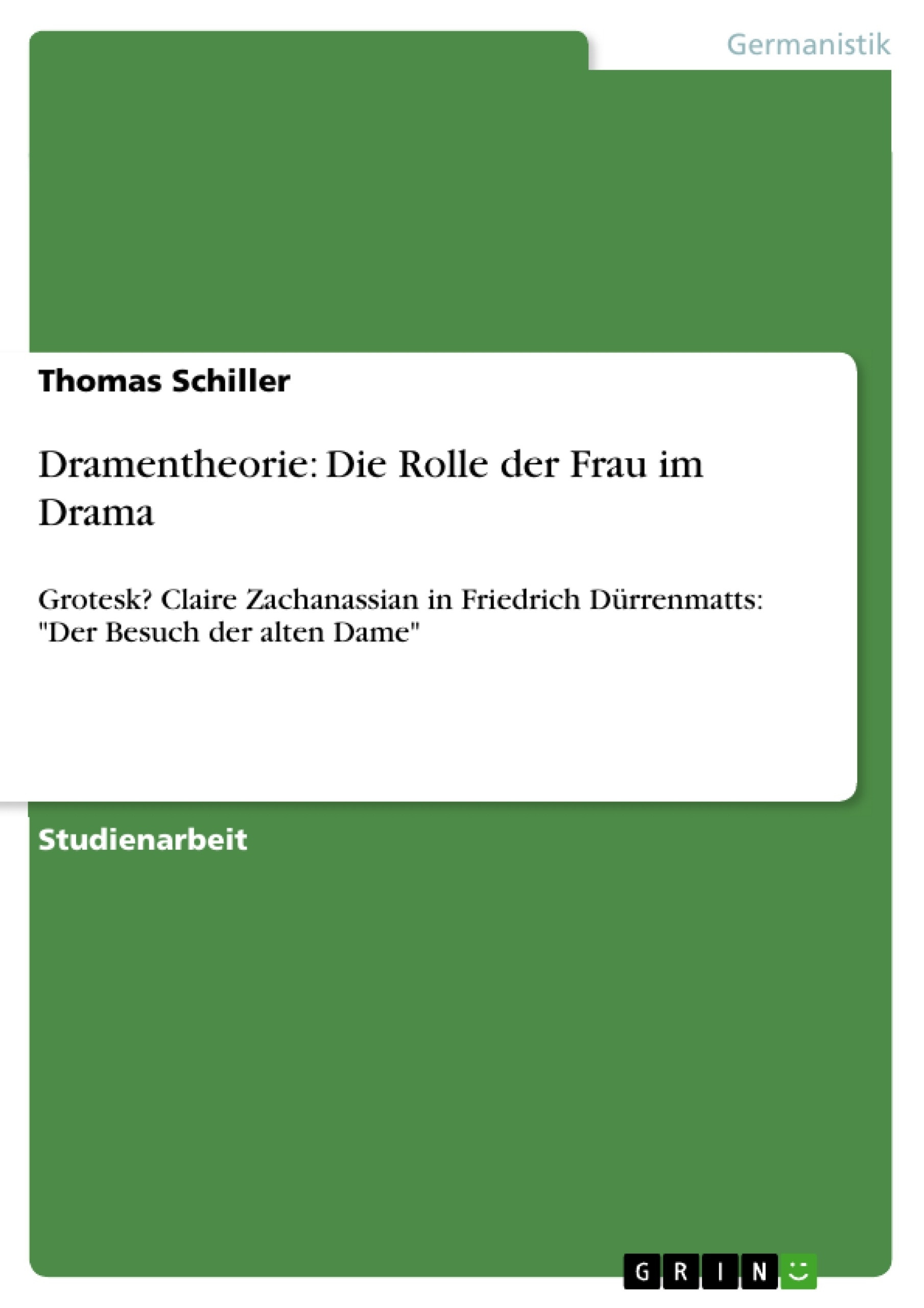Es soll geklärt werden, wie Claire Zachanassian im Rahmen des Stückes dargestellt wird und welche Rolle ihr darin zukommt. Dabei soll folgendermaßen vorgegangen werden: Da die Entstehungszeit relevant für das Textverständnis ist, erfolgt zuerst ein kurzer Überblick zu Genese und Rezeption des gesamten Stückes. Danach kann sich der Figur formal genähert und die Mittel der Personendarstellung geklärt werden. In diesen Kontext gehört, auf das Groteske als Stilmittel der Figurencharakterisierung einzugehen. Dies wird in einem gesonderten Kapitel geschehen. Ein Fazit darüber, in welchem Maße die eingangs gestellten Fragen nach dem Formalen und dem Grotesken der alten Dame beantwortet werden konnten und welche Sichtweisen ausgeklammert werden mussten, soll die Arbeit zusammenfassend abschließen.
Zur Auswahl des Themas haben den Verfasser drei Gründe bewogen. Zum einen das Interesse an der Dramentheorie des Schweizer Autors, zum anderen das Anliegen, den Begriff 'grotesk' näher zu untersuchen und letztendlich, eine weibliche Dramengestalt zu fokussieren, da im Rahmen des Seminars der Hauptakzent auf die Rolle der Frau im Drama gelegt wurde.
Als "formale Mittelpunktsfigur des Dramas" [Müller, Rolf: Komödie im Atomzeitalter. Gestaltung und Funktion des Komischen bei Friedrich Dürrenmatt. Frankfurt / Main, Bern, New York, Paris: Lang 1988. S.96.] wird sie beschrieben und als "groteske Zentralfigur des Stückes" [Ebd.]: Claire Zachanassian aus Friedrich Dürrenmatts tragischer Komödie "Der Besuch der alten Dame" [Dürrenmatt, Friedrich: Der Besuch der alten Dame. Eine tragische Komödie. In: Friedrich Dürrenmatt: Gesammelte Werke in sieben Bänden. Band 1: Stücke. Zürich: Diogenes 1991a. S.571-696.]. Andere, wie zum Beispiel Elisabeth Brock- Sulzer meinen, "Claire Zachanassian ist der Katalysator dieses Dramas - kaum mehr." [Brock-Sulzer, Elisabeth: Friedrich Dürrenmatt. Stationen seines Lebens. Mit Fotos, Zeichnungen, Faksimiles. Zürich: Diogenes 1986. S.80.]
Diese gegensätzlichen Aussagen sollen der vorliegenden Hausarbeit als Ansätze dienen.
Inhaltsverzeichnis
- Einleitung
- „Der Besuch der alten Dame“ – Hintergründe
- Entstehungshintergrund
- Aufführung und Rezeption
- Claire Zachanassian - Personendarstellung
- Äußeres Erscheinungsbild
- Charakteristische Eigenschaften
- Verkörperung von Handlungsfunktionen
- Namenssymbolik
- Mythologische Anspielungen
- Medea
- Lais
- Klotho
- Claire Zachanassians Requisite - Dienerschaft und Gepäck
- Die Personen im Gefolge der alten Dame
- Die Gatten VIII-IX
- Boby: Akademiker - Oberrichter – Butler
- Toby und Roby: Gangster - Todeskandidaten - Sänftenträger
- Koby und Loby – Die blinden Kastraten
- Der schwarze Panther
- Die mitgebrachten Utensilien
- Die Personen im Gefolge der alten Dame
- Claire Zachanassian - Das Groteske in persona ?
- Das Groteske - Versuch einer Standortbestimmung
- Definitionsversuch
- Aspekte des Grotesken bei Claire Zachanassian
- Die wesentlichen Unterschiede sind verwischt
- „Plötzlichkeit, das überraschende Moment, der Einfall in anderer Bedeutung“
- Fazit
Zielsetzung und Themenschwerpunkte
Diese Hausarbeit befasst sich mit der Figur der Claire Zachanassian in Friedrich Dürrenmatts „Der Besuch der alten Dame“ und analysiert ihre Darstellung im Kontext des Dramas. Dabei werden sowohl ihre äußeren Merkmale als auch ihre charakterlichen Eigenschaften sowie ihre Rolle in der Handlung beleuchtet. Ein besonderes Augenmerk liegt auf dem Stilmittel des Grotesken und seiner Bedeutung für die Figurencharakterisierung.
- Die Bedeutung der Figur Claire Zachanassian für die Handlung des Dramas
- Die Darstellung von Claire Zachanassian als groteske Figur
- Der Einfluss der Entstehungszeit auf die Thematik des Stückes
- Die Rezeption des Stücks und die Interpretation der Figur Claire Zachanassian
- Die Rolle des Grotesken in der Dramaturgie Dürrenmatts
Zusammenfassung der Kapitel
Die Einleitung führt in die Thematik der Hausarbeit ein und stellt die Relevanz der Figur Claire Zachanassian für das Verständnis des Dramas heraus. Anschließend werden die Hintergründe des Stückes beleuchtet, wobei sowohl das Entstehungsdatum als auch die Rezeption des Dramas thematisiert werden. Das dritte Kapitel widmet sich der Personendarstellung von Claire Zachanassian und betrachtet verschiedene Aspekte wie ihr äußeres Erscheinungsbild, ihre charakteristischen Eigenschaften, ihre Rolle in der Handlung und die Symbolik ihres Namens. Im vierten Kapitel wird die Frage untersucht, inwieweit Claire Zachanassian als groteske Figur dargestellt wird. Dazu werden zunächst verschiedene Definitionen des Grotesken diskutiert, bevor konkrete Aspekte der Figur auf ihre grotesken Merkmale hin analysiert werden.
Schlüsselwörter
Claire Zachanassian, Friedrich Dürrenmatt, Der Besuch der alten Dame, Groteske, Tragische Komödie, Personendarstellung, Figurenanalyse, Rezeption, Entstehungshintergrund, Dramaturgie, Nachkriegszeit, Wirtschaftswunder, Moral, Gesellschaft, Existenz, Macht, Rache, Gerechtigkeit.
- Quote paper
- Thomas Schiller (Author), 2003, Dramentheorie: Die Rolle der Frau im Drama, Munich, GRIN Verlag, https://www.grin.com/document/52034



